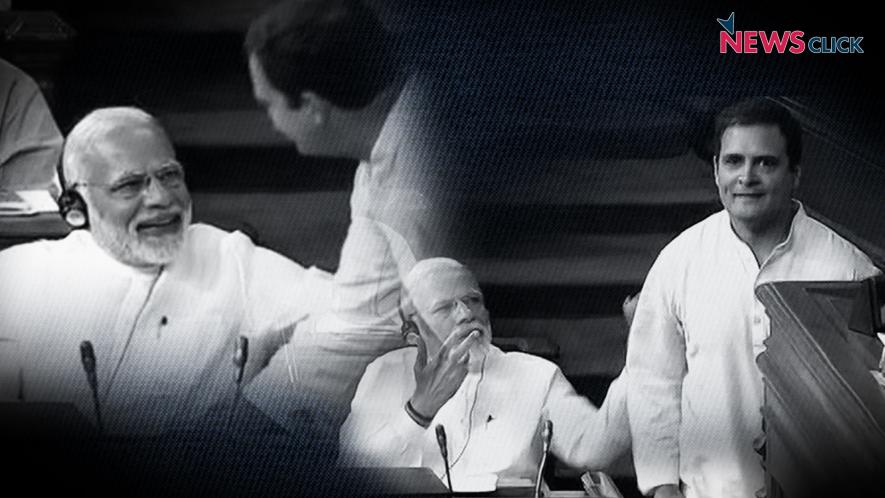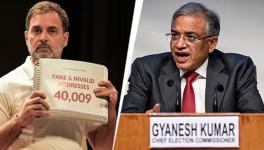Two Arms of the Oligarchy: Summing up Rahul Gandhi’s Hug and Wink Spectacle

For the past week, what has adorned headlines and opinion/editorial pages is the ending of Rahul Gandhi’s speech during the no-confidence motion against the Narendra Modi-led Bharatiya Janata Party government in the Lok Sabha – where Gandhi astonished parliamentarians and viewers alike by walking up to the seated prime minister, and embracing him. Before PM Modi could recover his composure, Mr. Gandhi was back on his chair, settling down and winking. From Hartosh Singh Bal and Mani Shankar Aiyar to mainstream columnists, there have been few intellectuals who have resisted the opportunity to weigh in on the matter.
The speech and the antics, which were telecast live, were acclaimed far and wide among the non-BJP-leaning sections of the media. All agreed that Mr. Gandhi ended up creating a successful PR spectacle out of a parliamentary motion which was doomed to fail.
Leaders of the BJP, along with Republic TV, Zee News, Times Now, Network18 and other pro-BJP media houses termed it a political act with no substance, and glorified the PM’s response.
There is one major angle unexplored: the week in the Parliament and in the news cycle, ended up essentially being spent not talking about issues that were to be tabled in the Lok Sabha during the beginning of the monsoon session – such as women's reservation in Parliament, and the much-needed debate over Section 377. If diversion from concrete action on burning issues was the goal, then the BJP and Congress collaborated on this ideologically.
Also Read: No-Trust Motion: Opposition Parties Highlighted the Unfulfilled Promises of BJP
There are many sections who believe Rahul Gandhi had accomplished nothing by “hugging a murderer” – that he was giving a certain political legitimacy to a man who, at one point, faced charges of abetting mass murders – something that over a decade ago, his mother, Sonia Gandhi had claimed as well, treating him like a political untouchable, and terming him a “maut ka saudagar” (merchant of death). How that was different from Jayant Sinha garlanding lynching accused, one may ask.
Tactically, the main purpose of the spectacle appears to be diverting the media news cycle away from current themes – going a long way in taking away the ”Muslim Party” tag that was being discussed. It turned out to be fake news, the only source being a reporter who was not present – but was causing the Congress a lot of political inconvenience in a polarised climate. It must be noted that the Congress itself has been, of late trying to Hinduise its image. Beginning from Shashi Tharoor’s Why I Am A Hindu to the presentation of Rahul Gandhi as a Krishna avatar in the last Gujarat assembly elections – the Congress seeks to neutralise the “Hindu” aspect of the BJP’s appeal till only religious extremism separates the BJP from the Congress.
Within the paradigm of the politics of the spectacle, what was allowed to transpire was very narrow in substance, ultimately. Demonetisation, lynchings, development were themes that were used, but the speech was a pragmatic critique based on and tailored to the BJP’s failures, rather than what the Congress could offer policy-wise.
In Mr. Gandhi’s speech, there was not an inkling of a policy agenda for 2019 – not on education, free healthcare for all, employment, higher minimum wage, offering minimum wage to Aanganwadi, ASHA and mid-day meal workers, women’s empowerment, reorienting class-wise tax burdens, caste issues, campaign finance, agrarian issues, reducing income inequality, or crucial environment issues.
There appear to be no counter bills to place before the Parliament or before the people as an alternative, something to mobilise public support and opinion over. There is no attempt to show that things could be handled in a different way.
The Congress and Rahul Gandhi’s team are trying their best to stick to a recently tried-and-tested formula – the politics of projection, essentially the Modi model. The drawback is, other than Indira Gandhi, no prime minister or prime ministerial candidate had ridden on a wave of their own making. Rajiv Gandhi’s 1984 victory wave was due to his mother’s death, the beginning of Jawaharlal Nehru’s career as elected PM was on the wave of the national movement. Even PM Modi, strong as his electoral PR in 2014 was, had to rely on the corrupt, scam-ridden image of UPA-II, to be able appear as a messiah of sorts during an anti-Congress wave.
The Modi model of PR that Mr Gandhi is now playing at, demands that as long as nobody knows what he stands for, and sharply attacks the incumbent - he shall do politically well. Some benefit appears to have come from the recent tactics as a CSDS-Lokniti poll shows Gandhi has a personal popularity rating almost as high as Modi’s, while showing that the current government has reached the same level in terms of unpopularity as the UPA-II government at its lowest. However, would Rahul Gandhi’s personal popularity translate well into the various communally polarised and caste-ridden constituencies which his party has to win in a parliamentary system?
Also Watch: No-Trust Motion: Two Questions That Will Trouble Modi in 2019
With his political takedown of the PM in Parliament, one can acknowledge that Rahul Gandhi has matured into a somewhat “leadership” role. But most of the media has taken sides already. The ideological ambiguity required if one is to not risk boycott by corporate donors has crippled the constructive populist policy propaganda the Congress could engage in – the only thing that can counter media bias and saffron hegemony. Namely, it is not a level-playing field for the opposition to beat the incumbent at its own game.
It is absolutely essential for anyone trying to recreate the Modi model of campaigning to sell a dream – selling one through policy promises based on standard of living would be more substantive, given the state of the economy and the people today. A progressive agenda can capture the imagination of the populace. One does not become an icon simply through swing votes and anti-incumbency.
When the political establishment is threatened, along with ruling class/caste privileges, the only acceptable form of populism undertaken in the country by parties is right-wing populism (and not left-wing economic populism) as an alternative to superficial liberalism – neither of which question rugged capitalism, corporate loot and increasing inequality. Vague promises of development, mostly based on supply-side economics and the trickle-down logic are permissible as they do not question the current economic hierarchy and the increasing corporate tax-cuts, disinvestment, conflicts of interest and the steady erosion of welfare.
There is only one takeaway from the debate – that the two major national parties, both of which have historically had contesting ideas of India, and today lie in pragmatic political opposition to each other – form two arms of the same corporate oligarchy.
The author is a PhD scholar in Modern and Contemporary History at Centre for Historical Studies, Jawaharlal Nehru University.
Get the latest reports & analysis with people's perspective on Protests, movements & deep analytical videos, discussions of the current affairs in your Telegram app. Subscribe to NewsClick's Telegram channel & get Real-Time updates on stories, as they get published on our website.























